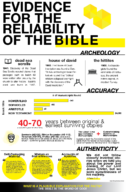How Reliable Are Our Texts?
Much of this video by Chuck Missler is based on the works of the Late Dr Ivan Papin. It tackels the question: How Do We Know The Bible Is The Word Of God? EVERYONE needs to spend time on it. Papin, a PhD in mathematics, is presenting us a series of mathematical and statistical readings from just the last twelve verses of the Book of Mark that must jar our nerves.

Please let me make a quick request: do NOT turn this off because of the talk of mathematics. The course itself is one of the simplest courses men can learn if you have someone to give you simple piece-by-piece explanations of its processes. In fact the physical world is only better described by this subject of order, weights and relationships.
Papin is describing an impossible order! We all must listen.
As a small introductory, the little statistics here is on the topic of probabilities. Probability is the study of the chance of something occurring either by itself or in conjunction or as a result of something else happening earlier or together. Much of the study here is on the elementary probability of things happening in an independent fashion.
An example of this is the probability of a particular number, say 4, turning up when we throw up a perfect, six-sided die. Since the die is perfect, each side has an equal chance of turning up. The possibility of 4 or 1 or 6 or any other number turning up is 1 in 6. This is giving us a figure of 1 over 6, or 0.1666667. This is the probability. The probability of the same thing happening any other time is the same 1 over 6 or 0.1666667.
The probability of 4 or 1 or 6 or any other number occurring in two consecutive occasions is a product of the individual probabilities. We just multiply the fractions or decimals. The probability of having 4 followed by another 4 from the throwing up of our die is 1/6 multiplied by 1/6. This is 1/36. The probability of us getting a third 4 when we throw up our perfect die is 1/36 x 1/6.
If, however, what we have is a perfect two-sided coin, the probability of either side turning up when we throw it is 1 in 2, or 0.5. The joint probability of one particular side turning up together upon two throws is 0.5 x 0.5 which is 0.25. I hope my readers can see that the probability figure of the joint occurrence of the event decreases as our throws grow. By the way, probabilities are only between zero and one: both of these two figures, 0 and 1, are certainties, negative or positive.
Back to Missler and Papin and Westcott and Hort and the NIV and the various other new Bible translations and Mark 16:9-20:
Unknown to the Satanists Westcott and Hort and their accomplices in the distortion of the Bible, the Author inserted non-compromisable, non-duplicable automatic protection codes featuring sevens (7) in His work. On attributes such as:
1 The total number of words
2 The total number of vocabularies (different words)
3 The number of letters
4 The number of vowels
5 The number of consonants
6 The numerical value of the letters etc etc,
Papin discovered the passage, reading in the original Greek, like other passages of the Bible, followed a rule of sevens!
With only 9 inserted attributes in these twelve verses, Papin calculated the chance of this passage being formulated by a human without an extra-terrestrial input at below 1 in 40 million!
71 = 7; Probability of it happening by chance, p=1/7
72 = 49; Probability, p=1/49
73= 343; Probability, p=1/343
74 = 2,401; Probability, p=1/2,401
75 = 16,807; Probability, p=1/16,807
76= 117,649; Probability, p=1/117,649
77= 823,543; Probability, p=1/823,543
78= 5,784,801; Probability, p=1/5,764,801
79= 40,353,607; Probability, p=1/40,353,607.
Stay on this Chuck Missler’s Youtube video. You will need to replay it very many times. You will be blessed.
It will direct you to take another hard look at your King James English Bible.